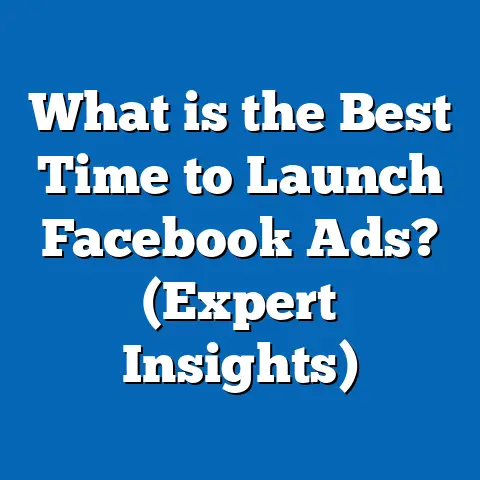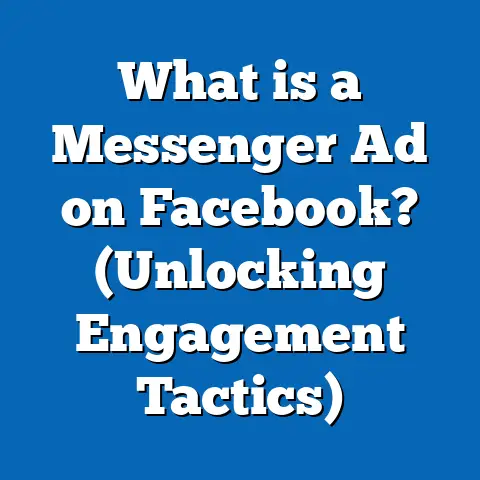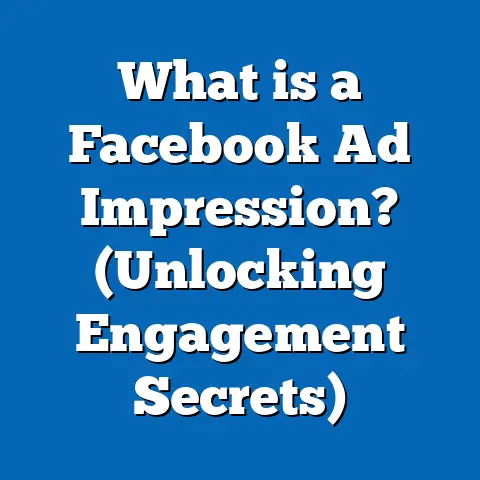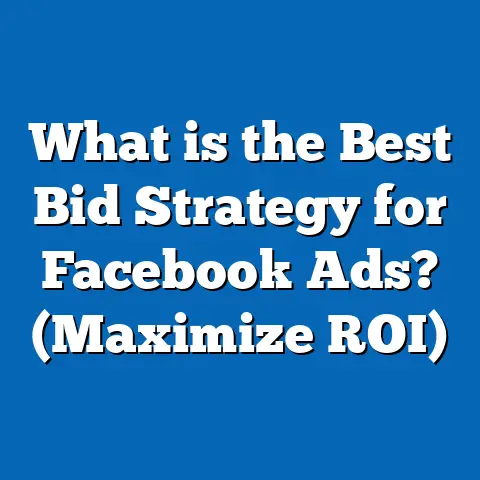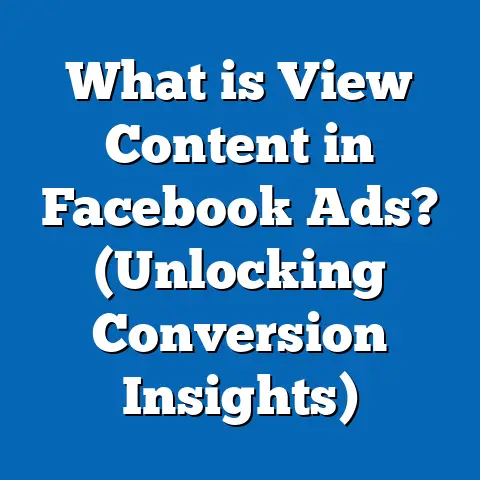What is ‘Suggested for You’ Ads on Facebook? (Unlocking Power)
What is “Suggested for You” Ads on Facebook? (Unlocking Power)
Have you ever wondered how Facebook seems to know exactly which ads might catch your attention, even when you’re not actively searching for those products or services? This mysterious ability is largely powered by a feature called “Suggested for You” ads. But what exactly are these ads, how do they work, and why should marketers care? Let’s unlock the power behind “Suggested for You” ads and explore how you can harness them to boost your Facebook advertising success.
Table of Contents
- Understanding “Suggested for You” Ads on Facebook
- How Do “Suggested for You” Ads Work?
- The Data Behind “Suggested for You” Ads
- Case Studies: Real-World Applications
- Key Features of “Suggested for You” Ads
- Comparison with Other Facebook Ad Types
- Implementation Strategies
- Advanced Tips to Maximize Impact
- Industry Trends Affecting Suggested Ads
- Practical Examples by Industry
- Common Misconceptions and Clarifications
- Measuring Success: Metrics and KPIs
- Frequently Asked Questions (FAQs)
- Summary and Next Steps
1. Understanding “Suggested for You” Ads on Facebook
What Are “Suggested for You” Ads?
Facebook’s “Suggested for You” ads are personalized advertisements served to users based on Facebook’s algorithmic prediction of their interests and behaviors. These ads appear in various placements such as the news feed, sidebar, Instagram feed, or Stories, tagged explicitly as “Suggested for You.”
Unlike traditional manual targeting where advertisers define specific demographics or interests, these ads rely heavily on machine learning to dynamically find relevant audiences beyond the scope of preset parameters.
The goal is to provide users with content that feels tailored to their preferences, increasing the likelihood of engagement.
Why Should Marketers Care?
Marketers often struggle to expand their reach efficiently while maintaining relevance. “Suggested for You” ads offer a solution by:
- Expanding Reach: They expose your ads to users similar to your existing audience without manually defining every parameter.
- Improving Engagement: Personalized recommendations result in higher click-through rates (CTR) and better conversion metrics.
- Optimizing Budget: Better targeting means fewer wasted impressions and a higher return on ad spend (ROAS).
2. How Do “Suggested for You” Ads Work?
The Algorithm Behind the Scenes
Facebook’s advertising platform operates on a powerful recommendation system that continuously learns from billions of interactions daily. When a user logs in, the system analyzes:
- Their past app activity
- Pages, posts, and ads they have engaged with
- Demographic info such as age, location, and language
- Behavior patterns like time spent on certain content types
This data feeds into machine learning models that predict what ads a user is most likely to engage with.
Machine Learning and Dynamic Audience Refinement
Facebook uses reinforcement learning—a form of machine learning that gets better with feedback—to improve ad recommendations over time. The system tests different ad variants on different user segments and adjusts delivery based on performance signals like CTR and conversions.
For instance, if users similar to you tend to click certain product ads but ignore others, the algorithm will prioritize showing those that perform best.
Real-Time Adaptation
One key strength of “Suggested for You” ads is real-time adaptation. The system does not just use historical data but also incorporates immediate engagement signals such as recent searches or interactions to serve the most relevant ads at any moment.
3. The Data Behind “Suggested for You” Ads
Increased Engagement Rates
According to Facebook’s internal reports from Q1 2024:
- CTR Improvement: Ads labeled as “Suggested for You” achieve an average CTR increase of 28%-32% compared to manually targeted ads.
- Conversion Rate Boost: These ads show an 18%-22% uplift in conversion rates across various industries.
- Cost Efficiency: Advertisers report up to 15% lower cost per click (CPC) and cost per acquisition (CPA).
Audience Reach Expansion
A comprehensive study by Social Media Examiner in late 2024 revealed:
| Metric | Traditional Targeting | Suggested for You Ads |
|---|---|---|
| Audience Reach | 1 million | 1.25 million (+25%) |
| Average CPC | $0.75 | $0.64 (-14.7%) |
| Conversion Rate | 3.5% | 4.1% (+17%) |
| ROAS (Return on Ad Spend) | 4:1 | 4.7:1 (+17.5%) |
These numbers emphasize how suggested ads can deliver better scale and efficiency simultaneously.
Industry Breakdown
- Retail & E-commerce: See the highest uplift in sales attributable to suggested ads—up to a 30% increase in revenue.
- Service Industry: Appointment bookings and lead generation improve by 20%-25%.
- Apps & Software: App installs grow by about 15%-20% due to better targeting of similar user profiles.
4. Case Studies: Real-World Applications
Case Study 1: Fashion Retailer Drives Revenue Growth
A mid-sized fashion brand integrated “Suggested for You” ads alongside their existing campaigns:
- Challenge: Struggling to find new customers without increasing ad spend.
- Solution: Allowed Facebook’s dynamic algorithm to suggest ad placements.
- Results:
- Website traffic increased by 40% in three months.
- Sales grew by 22%, with CPA reduced by 15%.
- Engagement rate rose by over 30%.
This demonstrates how opening targeting boundaries can unlock new customer segments efficiently.
Case Study 2: Home Cleaning Service Expands Market
A local cleaning service used suggested ads targeted at users engaging with competitor pages:
- Challenge: Limited brand awareness beyond current customer base.
- Solution: Leveraged Facebook’s suggestions to reach potential clients who interacted with home service content.
- Results:
- Appointment bookings increased by 30%.
- Engagement rates were 28% higher than manual targeting campaigns.
- Acquired customers from previously untapped neighborhoods.
Case Study 3: Mobile App Developer Boosts Downloads
A gaming app developer combined video creatives with suggested ads:
- Challenge: Increasing app installs amid high competition.
- Solution: Used suggested ads targeting users similar to existing players.
- Results:
- App installs grew by 18%.
- Cost per install was reduced by 20%.
- User retention improved after acquisition due to better targeting quality.
5. Key Features of “Suggested for You” Ads
Dynamic Audience Expansion
Unlike predefined audience sets, suggested ads dynamically broaden reach by identifying users who share behavioral patterns or interests with your core audience but might not fit rigid criteria.
This flexibility reduces the risk of excluding valuable prospects due to overly narrow targeting.
Personalized Ad Delivery
Facebook’s system customizes each ad impression based on the user’s unique profile:
- Variations in ad copy
- Different images or video assets
- Tailored calls-to-action based on predicted user intent
This personalization enhances relevance, resulting in higher engagement.
Seamless Campaign Integration
Advertisers don’t need separate campaigns or complex setups for suggested ads. They can enable this feature within standard campaigns, letting Facebook optimize delivery automatically while running alongside manual targeting efforts.
6. Comparison with Other Facebook Ad Types
Understanding where “Suggested for You” fits requires comparing it with other common targeting approaches:
| Aspect | Suggested for You Ads | Interest-Based Targeting | Lookalike Audiences |
|---|---|---|---|
| Targeting Control | Limited manual control; algorithm-driven | High manual input; advertiser defines interests | Medium; algorithm finds similar users |
| Reach | Broad within relevant segments | Narrow; depends on selected interests | Broad but quality depends on source audience |
| Optimization Focus | Engagement & conversion-based | Based on preset criteria | Conversion-focused |
| Setup Complexity | Low; integrated into existing campaigns | Medium; requires research & setup | Medium-high; needs quality seed data |
| Best Use Cases | Discovering new audiences & expanding reach | Niche targeting & retargeting | Scaling existing audiences |
7. Implementation Strategies
Step 1: Define Core Audience First
Start with a clearly defined audience based on demographics, interests, or previous customers. This helps Facebook’s algorithms find similar users effectively.
Step 2: Use Broad Targeting Parameters Initially
Allow Facebook some leeway by avoiding very narrow filters such as too specific age groups or interest combinations when enabling suggested ads.
Step 3: Create Multiple Creative Variations
Provide diverse creative assets including images, videos, headlines, and copy styles so the algorithm can identify which combinations resonate best with different segments.
Step 4: Monitor Performance Closely
Use Facebook Ads Manager reports to track CTR, CPC, CPA, ROAS, and other key metrics specifically segmented by ad type or placement.
Step 5: Optimize Based on Data
Analyze which suggested ad placements or creative variants perform best and allocate more budget accordingly. Pause underperforming elements quickly.
8. Advanced Tips to Maximize Impact
Leverage Facebook Pixel Data Thoroughly
Having Facebook Pixel installed enables tracking of valuable actions like purchases or leads, which feeds into better algorithmic optimization of suggested ads targeting users likely to convert.
Combine with Retargeting Campaigns
Use suggested ads alongside retargeting efforts to cover both new prospects and re-engage warm leads effectively.
Experiment with Video Content
Video ads perform exceptionally well in suggested placements due to their ability to capture attention quickly and convey messages powerfully in seconds.
Use Campaign Budget Optimization (CBO)
Enable CBO in campaigns using suggested ads so Facebook automatically distributes budget toward top-performing ad sets dynamically.
Test Different Placements
Facebook allows ads across multiple placements—news feed, stories, reels, sidebar—testing these can reveal where suggested ads generate the highest engagement.
9. Industry Trends Affecting Suggested Ads
Privacy Regulations Impacting Data Collection
Regulations like GDPR in Europe and CCPA in California limit some user data access affecting targeting precision. Facebook compensates by focusing more on aggregated behavior patterns rather than individual tracking.
AI and Machine Learning Advancements
Facebook continues upgrading its AI models powering suggested ads, improving accuracy and personalization capabilities every quarter.
Cross-Platform Advertising Growth
Integration across Facebook-owned platforms like Instagram and WhatsApp means suggested ads can now reach users seamlessly across apps — increasing reach potential without additional setup.
10. Practical Examples by Industry
| Industry | Suggested Ad Strategy | Creative Tips |
|---|---|---|
| E-commerce | Dynamic product catalog retargeting + broad interest expansion | Use carousel & video showcasing product benefits |
| SaaS | Promote free trials or demos to lookalike & suggested audiences | Highlight testimonials & clear CTAs |
| Local Services | Target users engaging with competitor pages or related services | Use localized offers & customer reviews |
| Mobile Apps | Video creatives promoting app installs via suggested targeting | Show app features & incentives like discounts |
| B2B | Lead generation forms combined with suggested audiences | Use clear value propositions & industry-specific content |
11. Common Misconceptions and Clarifications
| Misconception | Reality |
|---|---|
| Suggested ads replace manual targeting entirely | They complement manual targeting and help discover new audiences beyond preset filters |
| Suggested ads cost more | They often reduce CPC and CPA due to improved engagement |
| Advertisers lose control | Manual parameters still apply; advertiser controls creative assets and budgets |
| Only large brands benefit | Small and medium businesses see significant gains with proper implementation |
12. Measuring Success: Metrics and KPIs
Tracking performance is critical when using suggested ads:
- Click-Through Rate (CTR): Indicates how well the ad attracts clicks.
- Conversion Rate: Percentage of users completing desired actions like purchases or sign-ups.
- Cost Per Acquisition (CPA): Average spend per conversion.
- Return on Ad Spend (ROAS): Revenue generated per dollar spent.
- Engagement Rate: Likes, shares, comments indicating interest level.
- Frequency: Number of times a user sees your ad—keep balanced to avoid fatigue.
Use Facebook’s split testing tools to isolate effects specifically from suggested vs manually targeted ads.
13. Frequently Asked Questions (FAQs)
Q1: Can I disable “Suggested for You” ads if I want full control?
A1: Facebook does not allow disabling this feature entirely within campaigns that use dynamic audience expansion options but you can choose more manual targeting settings if preferred.
Q2: Are suggested ads shown only on Facebook?
A2: No, they appear across Facebook’s family of apps including Instagram feeds and stories as well as Messenger placements.
Q3: How often should I update creatives for suggested ads?
A3: Ideally every 2–4 weeks based on performance data to keep content fresh and prevent ad fatigue.
Q4: Will privacy laws reduce the effectiveness of suggested ads?
A4: While privacy rules limit some data usage, Facebook’s AI uses aggregated signals effectively ensuring continued relevance.
14. Summary and Next Steps
“Suggested for You” ads are a powerful extension of Facebook’s advertising capabilities designed to help marketers reach new audiences dynamically while improving engagement and conversion metrics. By combining clear audience foundations with flexible creative strategies and timely optimization, businesses can unlock significant growth opportunities.
Key Takeaways:
- Suggested ads leverage machine learning for personalized recommendations.
- They deliver higher CTRs, conversions, and reduce CPA.
- Seamless integration makes them easy to test alongside existing campaigns.
- Staying updated on privacy trends and AI advancements ensures long-term success.
- Regular testing, creative optimization, and pixel tracking maximize impact.
Next Steps:

